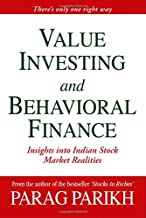Book Summary of Value Investing and Behavioral Finance
by Parag Parikh

What is this book about?
The book "Value Investing and Behavioral Finance: Insights into Indian Stock Market Realities" by Parag Parikh explores the principles of value investing and the application of behavioral finance in the context of the Indian stock market. The author combines his extensive experience in finance with insights from behavioral psychology to explain how emotional biases and irrational behaviors influence investment decisions. The book provides practical advice on how investors can avoid common pitfalls by adhering to the principles of value investing and understanding the psychological factors that often lead to poor decision-making.
Who should read the book?
This book is particularly suited for:
- Indian investors: Those interested in gaining a deeper understanding of the Indian stock market.
- Value investors: Individuals who follow or wish to follow the principles of value investing.
- Financial professionals: Investment advisors, portfolio managers, and financial analysts who want to incorporate behavioral finance into their investment strategies.
- Students of finance: Those studying investment strategies, stock markets, or behavioral finance.
- Long-term investors: Individuals who want to create and preserve wealth over time, especially in volatile markets.
10 Big Ideas from the Book
- Behavioral Biases: Investors often fall prey to biases such as overconfidence, herd behavior, and the desire for instant gratification, leading to irrational decisions.
- Contrarian Investing: Going against the crowd can yield significant returns, as markets often overreact to news and events.
- Growth Trap: Chasing high-growth stocks often leads to suboptimal returns due to overvaluation and unrealistic expectations.
- Value Investing: Buying undervalued stocks with solid fundamentals is the cornerstone of successful investing.
- Long-term Perspective: Patience and the ability to delay gratification are crucial for investment success.
- Market Sentiment: Stock prices are influenced as much by investor sentiment as by fundamentals, leading to market inefficiencies.
- Commodity Investing: Commodity stocks can offer opportunities during periods of economic distress, but they require a different analytical approach.
- IPO Pitfalls: Initial Public Offerings (IPOs) are often overpriced and driven by market euphoria, making them risky investments for value-oriented investors.
- Index Investing: Blindly following index funds can lead to missed opportunities; instead, selective investing based on value can outperform the market.
- Bubble Identification: Understanding and identifying financial bubbles can help investors avoid catastrophic losses and take advantage of market corrections.
Summary of "Value Investing and Behavioral Finance: Insights into Indian Stock Market Realities" by Parag Parikh
Book Overview: The book combines the principles of value investing with behavioral finance, providing insights into the unique dynamics of the Indian stock market. Parag Parikh draws on his extensive experience to discuss how psychological biases often lead to irrational investment decisions and how these can be mitigated by adhering to value investing principles.
Key Insights:
-
Behavioral Finance and Emotional Control:
- The book emphasizes that understanding and controlling emotions is crucial for investment success. Parikh argues that while intelligence is important, emotional control (Emotional Quotient, or EQ) plays an equally significant role. This is particularly relevant in volatile markets like India, where investor behavior is often driven by herd mentality, fear, and greed.
-
The Importance of Acquisition Price:
- The price at which you acquire a stock largely determines your return. Parikh demonstrates that a low acquisition price in a fundamentally strong company can lead to significant returns over time, even in a market where sentiments fluctuate wildly.
-
Price-to-Earnings (P/E) Ratio:
- P/E ratio is a critical metric in value investing. Parikh uses extensive data to show that investing in low P/E stocks—often out-of-favor with the majority—tends to outperform high P/E stocks in the long term. This supports the contrarian approach to investing.
-
The Growth Trap:
- The book warns against the "growth trap," where investors chase high-growth stocks with unrealistic expectations, often leading to poor returns when growth slows down or fails to meet expectations. Parikh suggests that long-term success is more likely with companies that have steady, sustainable growth rather than those with meteoric, unpredictable rises.
-
Contrarian Investing:
- Parikh advocates for a contrarian investment strategy—buying stocks that are out of favor with the market. This approach requires patience and discipline, as it often involves going against prevailing market sentiment.
-
Understanding Market Sentiment:
- The book details how market sentiment, driven by macroeconomic factors, regulatory changes, and overall optimism or pessimism, can lead to mispricing opportunities. Investors who recognize these opportunities can capitalize on them by making rational investment decisions when others are driven by emotion.
-
The Role of Speculative Returns:
- Parikh breaks down stock returns into fundamental and speculative components, illustrating that speculative returns—driven by changes in market sentiment—can significantly impact overall returns. He argues that successful investors focus on fundamental returns and view speculative returns as a bonus.
-
Commodity Investing:
- The book explores the nuances of investing in commodity stocks, which are often cyclical and volatile. Parikh suggests that while these stocks might not meet traditional value investing criteria, they can be lucrative if bought at the right time—when prices are beaten down and a revival in the commodity's price is anticipated.
-
Public Sector Units (PSUs):
- Parikh provides a nuanced view of investing in Indian PSUs, which are often undervalued due to their government ownership and perceived inefficiencies. He shows how some PSUs have thrived post-liberalization, offering good returns to investors who adopted a long-term, contrarian approach.
-
Sector Investing:
- Parikh cautions against investing in sectors simply because they are currently in favor. Instead, he recommends a more analytical approach that considers the long-term potential of sectors and the companies within them, rather than following market trends blindly.
Key Metrics and Ratios:
-
Price-to-Earnings (P/E) Ratio:
- Significance: The P/E ratio is crucial for evaluating whether a stock is overvalued or undervalued relative to its earnings. A lower P/E ratio may indicate a potential bargain, especially in a company with stable earnings.
-
Price-to-Book (P/B) Ratio:
- Significance: The P/B ratio helps assess whether a stock is trading below its actual worth. A low P/B ratio might suggest an undervalued stock, particularly in industries where assets are key, like in the case of public sector units (PSUs).
-
Return on Capital Employed (ROCE):
- Significance: ROCE is a measure of how efficiently a company uses its capital to generate profits. A higher ROCE indicates better management and efficient use of capital, making it a vital metric for evaluating long-term investment potential.
-
Debt-to-Equity Ratio:
- Significance: This ratio indicates the financial leverage of a company. A lower debt-to-equity ratio suggests a more stable company with lower financial risk, which is particularly important in industries with high capital expenditure.
-
Dividend Yield:
- Significance: Dividend yield measures the return on investment from dividends alone. A consistent or growing dividend yield can be a sign of a company’s financial health and a source of steady income for investors.
-
Price/Earnings to Growth (PEG) Ratio:
- Significance: The PEG ratio combines the P/E ratio with expected earnings growth, providing a more complete picture of valuation. A lower PEG ratio suggests that a stock may be undervalued relative to its growth potential.
-
Fundamental vs. Speculative Returns:
- Significance: Understanding the difference between fundamental returns (driven by earnings) and speculative returns (driven by changes in market sentiment) helps investors focus on sustainable long-term gains rather than short-term market movements.
-
Risk-Reward Ratio:
- Significance: This ratio helps in evaluating the potential reward of an investment relative to its risk. It is essential for making informed decisions, particularly in volatile markets like India’s.
-
Replacement Cost:
- Significance: Replacement cost is a concept used to value a company based on what it would cost to replace its assets. This is particularly relevant in industries where assets play a crucial role, such as in commodity-based companies or PSUs.
-
Market Capitalization:
- Significance: Market capitalization indicates the total market value of a company’s outstanding shares and is a key metric for comparing the size and stability of different companies.
This summary and the insights provided should give you a solid understanding of the concepts discussed in Parag Parikh's book and how they apply to investing in the Indian stock market.
Which Other Books are Used as References?
The book references works from a variety of scholars and practitioners in the fields of value investing and behavioral finance. Some notable references include:
- Benjamin Graham's "The Intelligent Investor": A foundational text on value investing.
- Daniel Kahneman and Amos Tversky's work on Prospect Theory: Foundational research in behavioral finance.
- Christopher Browne's lectures on value investing and behavioral finance: Providing practical insights into the application of these concepts.
- Gustave Le Bon's "The Crowd" and Charles Mackay's "Extraordinary Popular Delusions": Classic works on crowd psychology and the behavior of markets.
- Jeremy Siegel's "Future for Investors": Discussing the concept of the growth trap and long-term investing.
- David Dreman's and Michael Mauboussin's writings: On contrarian investing and market inefficiencies.
These references support Parikh's arguments and offer additional perspectives for readers interested in further exploring the topics discussed in the book.
Browse Summaries of Top Investing books!
You may also like the below Video Courses



